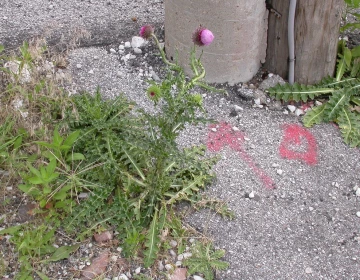What is the difference between a native and a non-native plant?
Image

This musk thistle was growing in a parking lot in downtown St. Louis on June 28, 2015
Photo by MDC Staff, courtesy Missouri Department of Conservation.
- Native plants are those that have evolved in a certain region, ecosystem or habitat without any direct or indirect human influence. They may also be called "indigenous" plants.
- Non-native plants, which may also be called "exotic" or "introduced," appear in locations through human influence, whether direct or indirect, intentional or unintentional. In the United States, many invasive plants were brought accidentally in shipments of grains. Tamarisk, on the other hand, was intentionally brought to control erosion on river banks. And Dalmatian toadflax, native to southeastern Europe, was introduced as a garden ornamental and has since escaped into natural areas.
What makes a plant invasive?
Invasive plants are aggressive spreaders and/or prolific reproducers, which can adapt to a variety of conditions and have few natural controls in their new habitat. The animals, birds, insects, and fungi that controlled them in their native habitat are absent. They are difficult to control or eliminate once established. In certain situations, such as over-grazed pastures, even native plants can become invasive.
An invasive plant can be native, non-native, or noxious.
- When a population of native (or indigenous) plants becomes too dense, those plants may also be considered invasive, if they have a negative impact on the abundance or health of other populations of plants, insects, birds, or wildlife.
- Non-native plants are those that have been brought into an area by human activity, such as hiking, farming, ranching, or driving vehicles. This often occurs accidentally, but may also occur intentionally before the impact of introducing the new plant is known. This is the case with Dalmatian toadflax and tamarisk.
- Both native and non-native plants can be considered noxious (a legal term assigned by federal, state, or county governments), if they are known to have a negative impact on agriculture, navigation, fish, wildlife, or public health. About half of all noxious weeds were garden escapees. Early detection and quick response is critical to slow their spread and protect weed-free areas. In some locations outside Arizona, landowners are legally required to remove noxious plants.
For a homeowner, a weed is any unwanted plant. It can even be a desirable plant that is simply growing in the wrong place.
References:
- Invasive plants C. E. Bell, University of California Integrated Pest Management
- Noxious weed list for Arizona. Arizona Department of Agriculture
